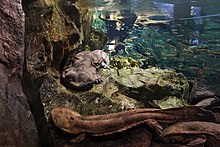| Giant salamanders Temporal range:
| |
|---|---|

| |
| Andrias japonicus | |
| Scientific classification | |
| Domain: | Eukaryota |
| Kingdom: | Animalia |
| Phylum: | Chordata |
| Class: | Amphibia |
| Order: | Urodela |
| Suborder: | Cryptobranchoidea |
| Family: | Cryptobranchidae Fitzinger, 1826 |
| Genera | |
The Cryptobranchidae (commonly known as giant salamanders) are a family of large salamanders that are fully aquatic. The family includes some of the largest living amphibians. They are native to China, Japan, and the eastern United States. Giant salamanders constitute one of two living families—the other being the Asiatic salamanders belonging to the family Hynobiidae—within the Cryptobranchoidea, one of two main divisions of living salamanders.
The largest species are in the genus Andrias, native to east Asia. The South China giant salamander (Andrias sligoi), can reach a length of 1.8 m (5.9 ft).[1] The Japanese giant salamander (Andrias japonicus) reaches up to 1.44 m (4.7 ft) in length, feeds at night on fish and crustaceans, and has been known to live for more than 50 years in captivity.[2]
The hellbender (Cryptobranchus alleganiensis) inhabits the eastern United States and is the only member of the genus Cryptobranchus.
- ^ Andrias davidianus. AmphibiaWeb: Information on amphibian biology and conservation. 2012. Berkeley, California: AmphibiaWeb. Retrieved 13 December 2012.
- ^ Andrias japonicus. AmphibiaWeb: Information on amphibian biology and conservation. 2012. Berkeley, California: AmphibiaWeb. Retrieved 13 December 2012.